Design of Novel Reconfigurable Single-Board Satellite for Enhanced Space Environment Detection
Abstract
:1. Introduction
2. Space Environment Detection Needs Analysis
2.1. Analysis of Balloon Satellite Detection Needs
- An energy unit, including solar panels, to provide power to all units;
- A GNSS unit for recording position and velocity;
- A communication unit for ground-based data transfer;
- A controller unit for mode control and GNSS data integration.
2.2. Analysis of Ionospheric Occultation Detection Needs
- An energy unit, including solar panels, to provide power to all units;
- A GNSS unit for recording pseudo-range and phase data;
- A communication unit for ground-based data transfer;
- A controller unit for mode control and GNSS data integration.
2.3. Summary
3. Design of a Single-Board Satellite
- Detection task state: In the specified detection mode, it performs atmospheric density measurements or occultation detection of the corresponding space environment.
- Data transmission state: During the satellite-to-ground communication windows, it is responsible for communication with ground stations, including data uplink and downlink. Data uplink refers to the process whereby ground stations send reconfiguration code data and telecommand instructions to the single-board satellite for storage. Data downlink involves transmitting onboard detection data and telemetry data to ground stations via the transceiver.
- Reconfiguration state: Primarily responsible for tasks involving software function changes and program execution address transitions carried out by the onboard microcontroller. This state facilitates updates to the onboard detection mode.
- Standby state: Entered when energy is insufficient. During this state, the satellite solely charges to provide power for subsequent detection tasks. Since lithium batteries are used to store energy, the specific switching of the standby state is determined based on the voltage.
- Design solar panels with front and backside-mounted patches to achieve near-omnidirectional coverage;
- Arrange the GNSS antennas in two sets of back-to-back antennas to attain near-omnidirectional coverage;
- Data transmission and communication antennas employ mature UV band omnidirectional antennas to achieve near-omnidirectional coverage;
- Implement a simplified reconfiguration using an ARM-based microcontroller (MCU) without the combination of traditional FPGA and SoC methods, offering low power consumption and miniaturization.
4. Feasibility Analysis
4.1. Communication Link Analysis
- denotes the space-to-ground communication link margin, which indicates link reliability. In real-world space-to-ground communication links, a value of 3–6 dB or higher is appropriate;
- EIRP stands for effective isotropic radiated power and represents the transmission power capability of the transmitter. It is related to the transmission of power , antenna gain , and feeder loss ;
- represents free space loss, a reduction in energy caused by the spherical spread of electromagnetic waves. It is primarily determined by transmission distance (in meters) and frequency (in Hz) and constitutes the most significant loss in the link;
- is the quality factor at the receiving end, referring to the gain-to-system noise ratio. It characterizes the system’s receiving capability. Here, is the receiving end’s antenna gain, is the receiving end’s feeder loss, and T is the equivalent noise temperature of the receiving antenna;
- encompasses other combined losses during propagation, including atmospheric loss, antenna polarization loss, and ionospheric loss. stands for code rate, represents Boltzmann’s constant, valued at −228.6 dB/Hz·K, and signifies the signal-to-noise ratio per code element, which can be found in standard tables [27].
4.1.1. Downlink Margin Analysis
4.1.2. Uplink Margin Analysis
4.1.3. Data Volume Analysis
- Balloon Satellite Atmospheric Density Data Volume Analysis
- 2.
- Ionospheric Occultation Data Volume Analysis
- 3.
- Data Transmission Capability Analysis
4.2. Energy Consumption Analysis
5. Software-Based Approach for Online Reconfiguration
6. Prototype and Verification of Online Reconfiguration Functionality
6.1. The Prototype
6.2. Verification of Online Reconfiguration Functionality
7. Conclusions
Author Contributions
Funding
Data Availability Statement
Conflicts of Interest
References
- Luo, B.X.; Wang, R.L.; Liu, W.; Yan, R.D.; Ren, T.L.; Ren, S.Y.; Liu, S.Q.; Lei, J.H. Analysis of the space environment where “Star Chain” satellite was destroyed by geomagnetic storm. Space Int. 2022, 5, 35–39. [Google Scholar]
- Davies, K.; Smith, E.K. Ionospheric effects on satellite land mobile systems. IEEE Antennas Propag. Mag. 2002, 44, 24–31. [Google Scholar] [CrossRef]
- Liu, Y.Y. Analysis of orbital inclination changes for “Atmosphere No.1” balloon satellite. Acta Astron. Sin. 1995, 2, 200–207. [Google Scholar]
- Liu, W.; Luo, B.X.; Gong, J.C.; Wang, R.L.; Rong, J.G. Study on dynamic correction model of thermospheric atmospheric density. Spacecr. Environ. Eng. 2023, 40, 213–219. [Google Scholar]
- Yang, H.L.; Wang, Y.N.; Dou, X.H.; Li, X.Y. “Force Rocket” No.1 Technology and Innovation. Aerosp. China 2023, 3, 14–18. [Google Scholar]
- Fish, C.S.; Swenson, C.M.; Crowley, G.; Barjatya, A.; Neilsen, T.; Gunther, J.; Azeem, I.; Pilinski, M.; Wilder, R.; Allen, D.; et al. Design, development, implementation, and on-orbit performance of the dynamic ionosphere CubeSat experiment mission. Space Sci. Rev. 2014, 181, 61–120. [Google Scholar] [CrossRef]
- Liu, W.; Liu, S.Q.; Gong, J.C.; Wang, R.L.; Rong, J.G. Near-space free-fall detection simulation analysis. Equip. Environ. Eng. 2020, 17, 1–7. [Google Scholar]
- Shi, D.B.; Hu, X.; Tu, C.; Wei, F.; Wang, X.Y. Near-space environmental sounding rocket expanded free-fall detection technology. Equip. Environ. Eng. 2018, 15, 89–92. [Google Scholar]
- Wu, X.C.; Hu, X.; Zhang, X.X.; Wickert, J. Ionospheric GPS occultation observation correction TEC inversion method. Chin. J. Geophys. 2006, 2, 328–334. [Google Scholar]
- Lin, Z.; Niu, H.; An, K.; Wang, Y.; Zheng, G.; Chatzinotas, S.; Hu, Y. Refracting RIS Aided Hybrid Satellite-Terrestrial Relay Networks: Joint Beamforming Design and Optimization. IEEE Trans. Aerosp. Electron. Syst. 2022, 58, 3717–3724. [Google Scholar] [CrossRef]
- Lin, Z.; Lin, M.; Champagne, B.; Zhu, W.P.; Al-Dhahir, N. Secrecy-Energy Efficient Hybrid Beamforming for Satellite-Terrestrial Integrated Networks. IEEE Trans. Commun. 2021, 69, 6345–6360. [Google Scholar] [CrossRef]
- An, K.; Lin, M.; Ouyang, J.; Zhu, W.P. Secure Transmission in Cognitive Satellite Terrestrial Networks. IEEE J. Sel. Areas Commun. 2016, 34, 3025–3037. [Google Scholar] [CrossRef]
- Lin, Z.; An, K.; Niu, H.; Hu, Y.; Chatzinotas, S.; Zheng, G.; Wang, J. SLNR-Based Secure Energy Efficient Beamforming in Multibeam Satellite Systems. IEEE Trans. Aerosp. Electron. Syst. 2023, 59, 2085–2088. [Google Scholar] [CrossRef]
- Su, R.F.; Zhang, K.K.; Song, H.W. Summarization of very small satellite development. Spacecr. Eng. 2013, 22, 104–111. [Google Scholar]
- Barnhart, D.J.; Vladimirova, T.; Sweeting, M.N. Verysmall-satellite design for distributed space missions. J. Spacecr. Rockets 2007, 44, 1294–1306. [Google Scholar] [CrossRef]
- San Luis Obispo, C.A. CubeSat Design Specification. 2023. Available online: https://static1.squarespace.com/static/5418c831e4b0fa4ecac1bacd/t/5f24997b6deea10cc52bb016/1596234122437/CDS+REV14+2020-07-31+DRAFT.pdf (accessed on 20 April 2023).
- Li, J.F. Research on On-Board Software Reconfiguration Technology of CubeSat. Master’s Thesis, Nanjing University of Science and Technology, Beijing, China, 2019. [Google Scholar]
- Barnhart, D.J.; Vladimirova, T.; Sweeting, M.N. Satellite miniaturization techniques for space sensor networks. J. Spacecr. Rocket. 2009, 46, 469–472. [Google Scholar] [CrossRef]
- Barnhart, D.J.; Vladimirova, T.; Baker, A.M.; Sweeting, M.N. A low-cost femtosatellite to enable distributed space missions. Acta Astronaut. 2009, 64, 1123–1143. [Google Scholar] [CrossRef]
- McVittie, G.; Kumar, K. Design of a COTS Femtosatellite and Mission. In Proceedings of the AIAA SPACE 2007 Conference & Exposition, Long Beach, CA, USA, 18–20 September 2007. [Google Scholar]
- Yang, L.; Guo, J.; Fan, C.; Song, X.; Wu, S.; Zhao, Y. The design and experiment of stardust femto-satellite. Acta Astronaut. 2020, 174, 72–81. [Google Scholar] [CrossRef]
- Jones, M.L.; Peterson, W.J. Falling Sphere Measurements, 30 to 120 km. Meteorol. Monogr. 1968, 8, 176–189. [Google Scholar]
- Liou, Y.A.; Pavelyev, A.G.; Liu, S.F.; Pavelyev, A.A.; Yen, N.; Huang, C.Y.; Fong, C.J. FORMOSAT-3/COSMIC GPS Radio Occultation Mission: Preliminary Results. IEEE Trans. Geosci. Remote Sens. 2007, 45, 3813–3826. [Google Scholar] [CrossRef]
- Ludwig-Barbosa, V.; Sievert, T.; Carlström, A.; Pettersson, M.I.; Vu, V.T.; Rasch, J. Supervised Detection of Ionospheric Scintillation in Low-Latitude Radio Occultation Measurements. Remote Sens. 2021, 13, 1690. [Google Scholar] [CrossRef]
- GJB 5421-2005; Methods for Calculation and Calibration of Satellite-Earth Data Transmission Link. Commission of Science, Technology and Industry for National Defense: Beijing, China, 2005.
- Wang, M.Y. Satellite remote sensing data link design. Space Electron. Technol. 2003, 2, 1–3+36. [Google Scholar]
- Fan, C.X.; Cao, L.N. Principles of Communications, 7th ed.; National Defense Industry Press: Beijing, China, 2013. [Google Scholar]
- Mao, Y.; Song, X.Y.; Jia, X.L.; Wu, X.B. Earth Eclipse Status Analysis of Beidou Navigation Satellites. Acta Geo-Daet. Cartogr. Sin. 2014, 43, 353–359. [Google Scholar]
- Sheng, T.; Bai, Y.Z.; Zhao, Y.; Chen, X.Q.; Chen, L.H. Energy balance simulation of board nano-satellite power system. J. Natl. Univ. Def. Technol. 2015, 37, 101–106. [Google Scholar]
- Lei, W.Y.; Ao, Z.L.; Zhou, Q.Q. In application programming (IAP) development based on STM32. Electron. Meas. Technol. 2015, 38, 62–66. [Google Scholar]
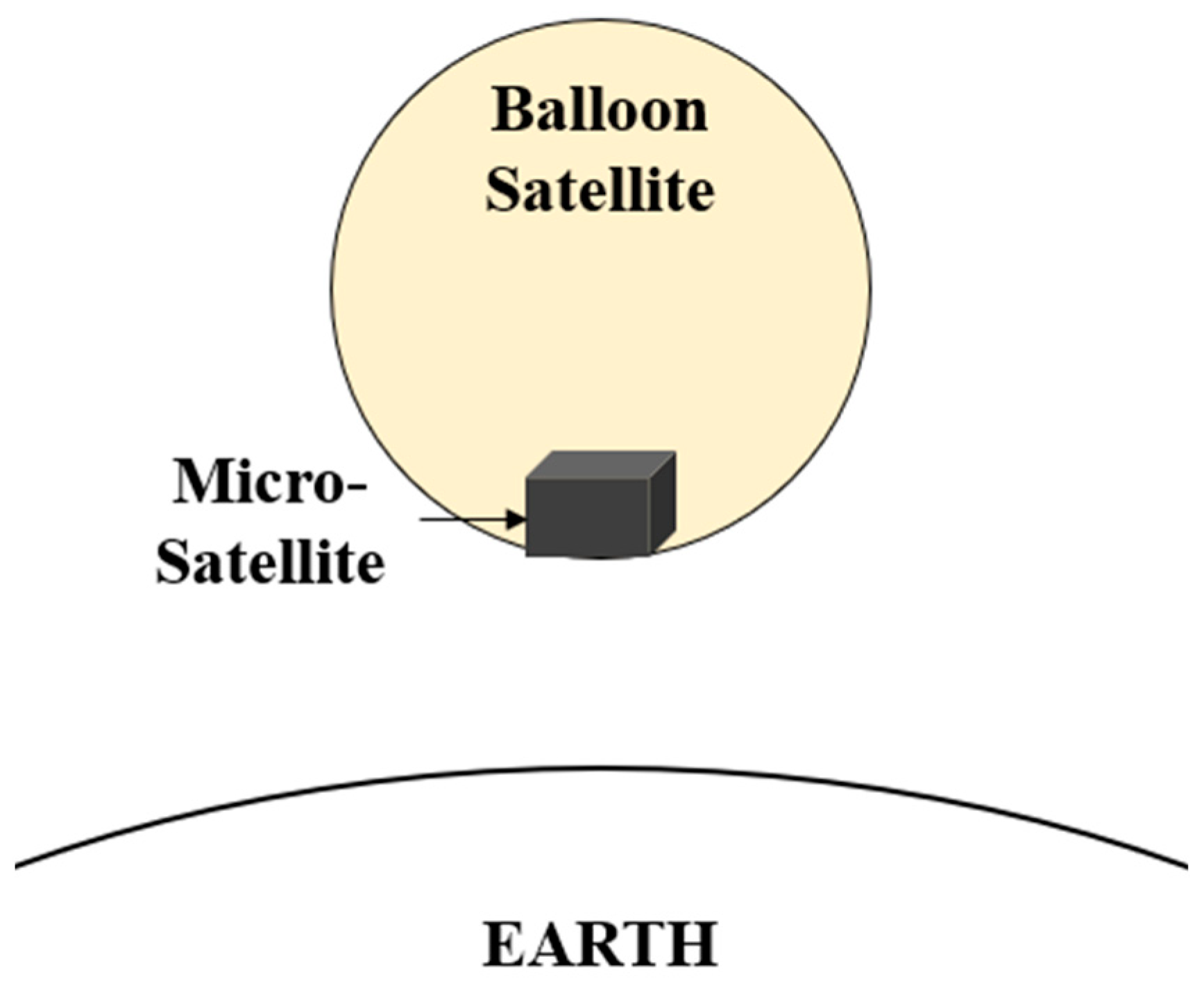
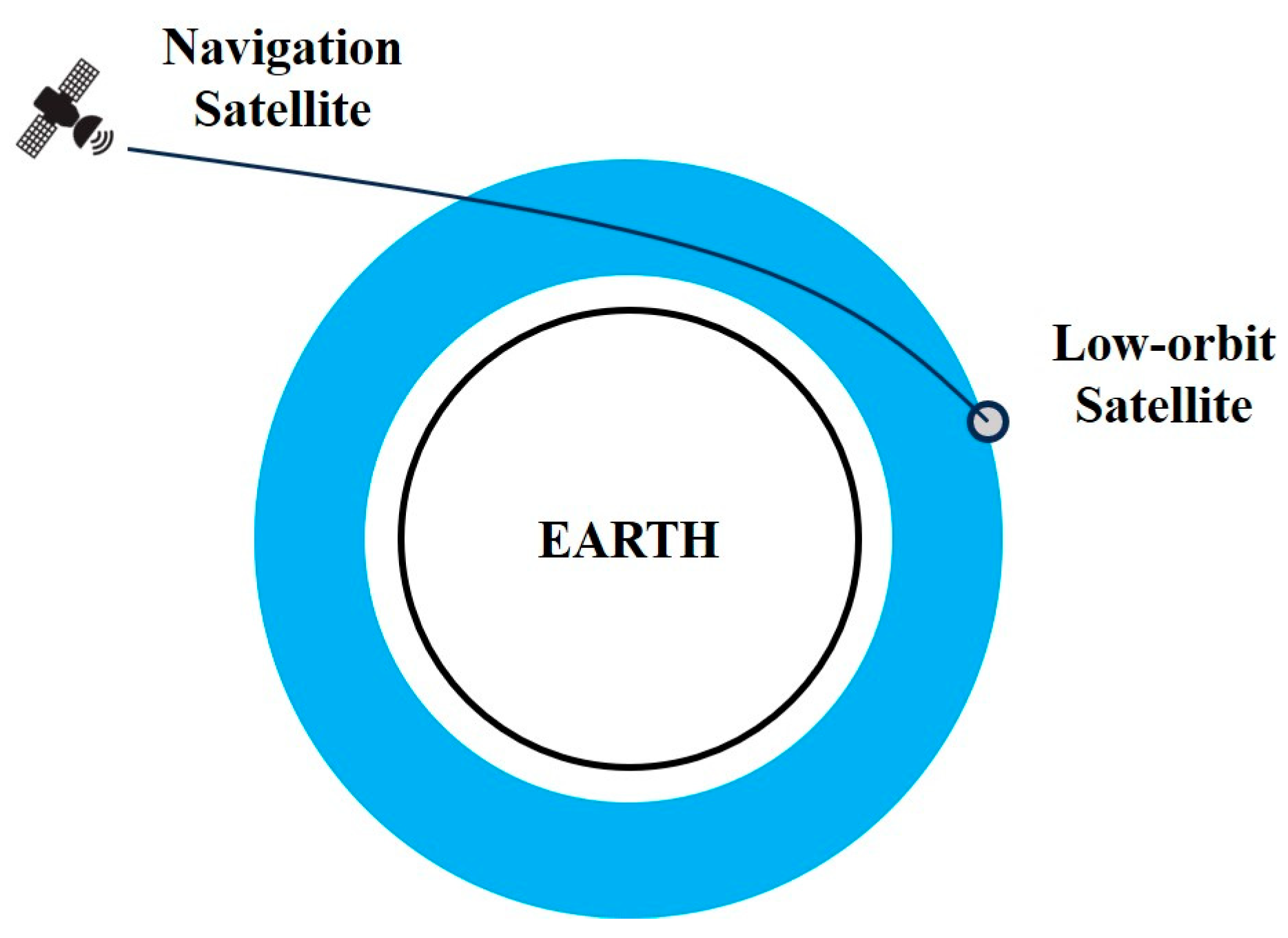

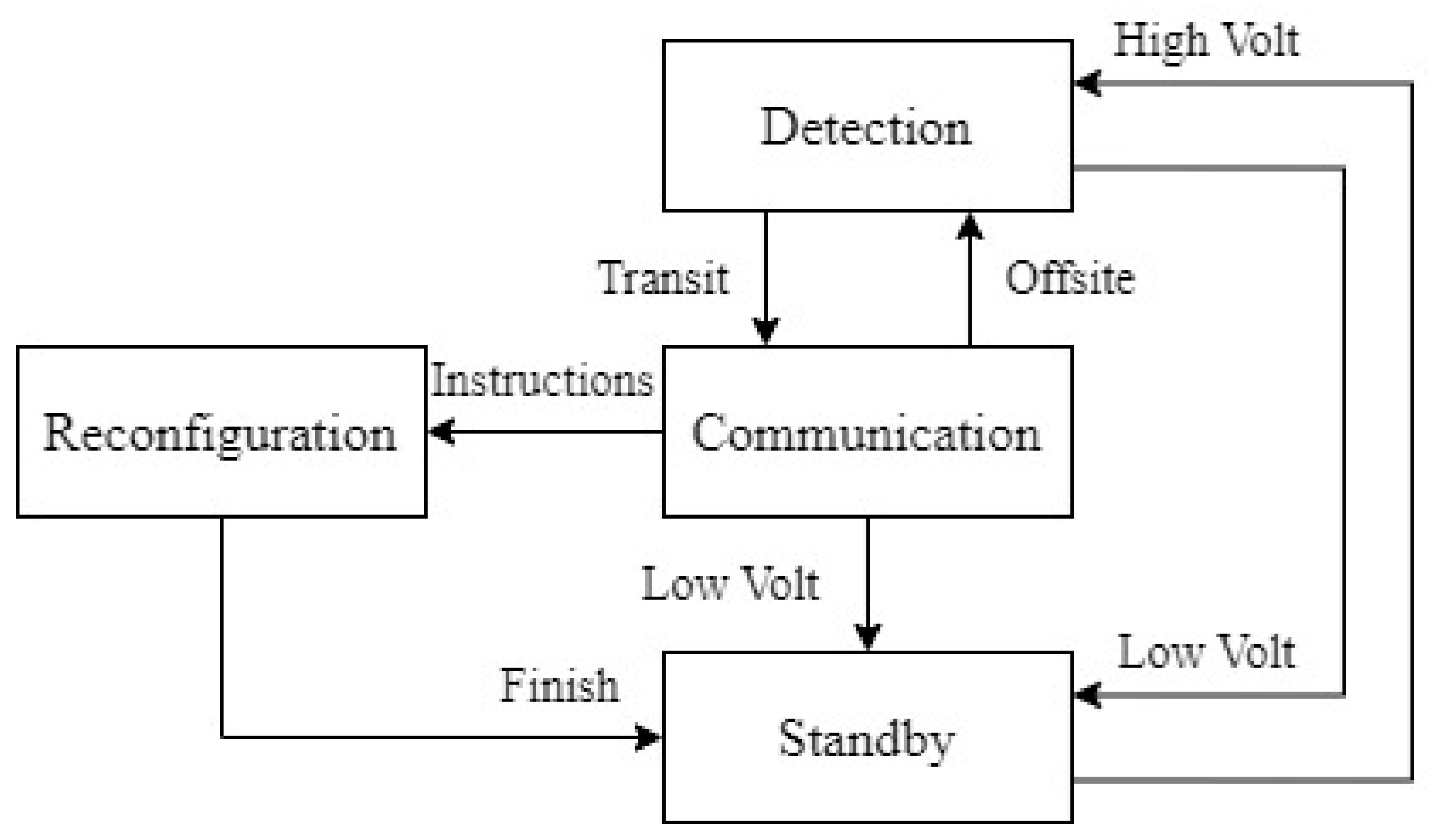


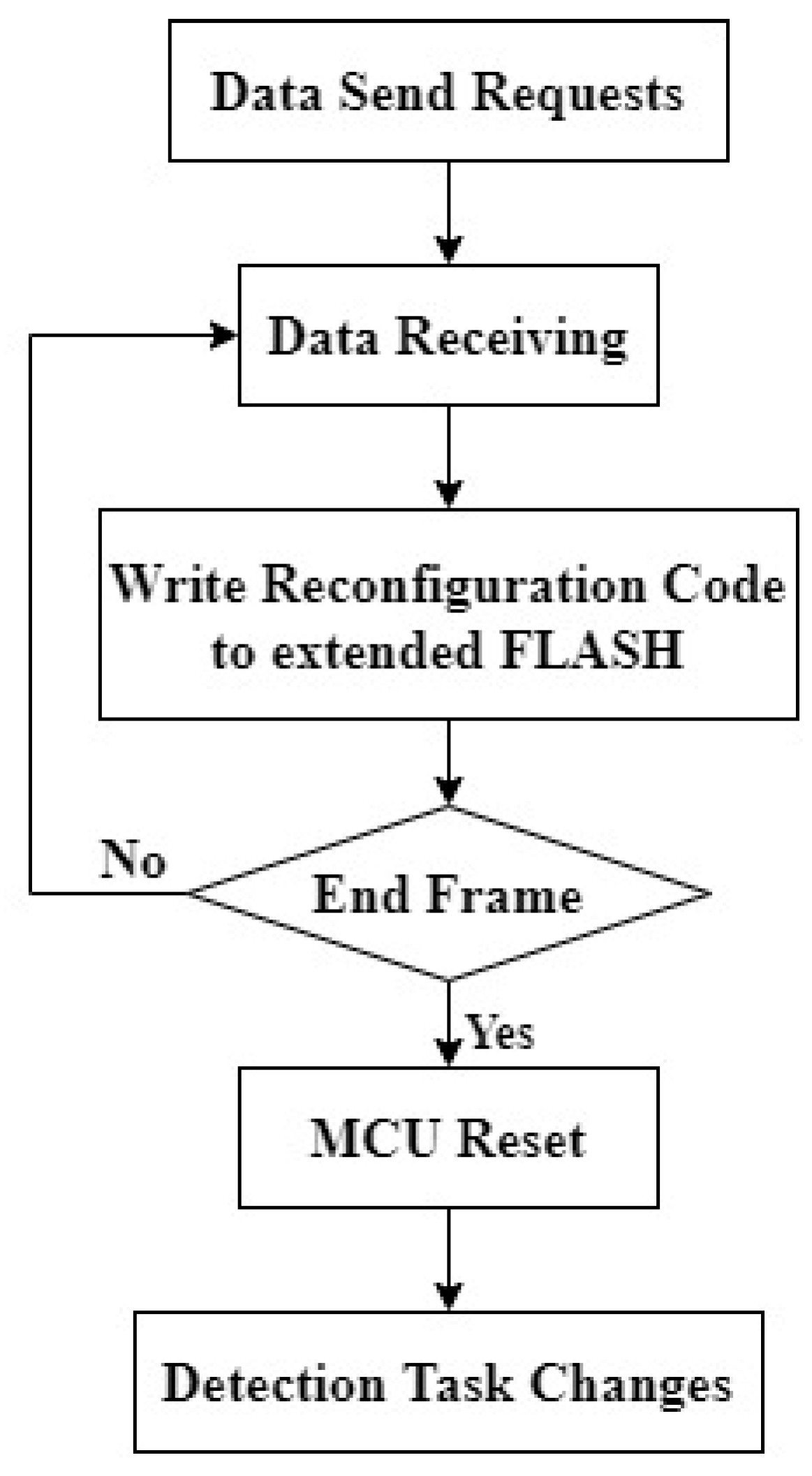

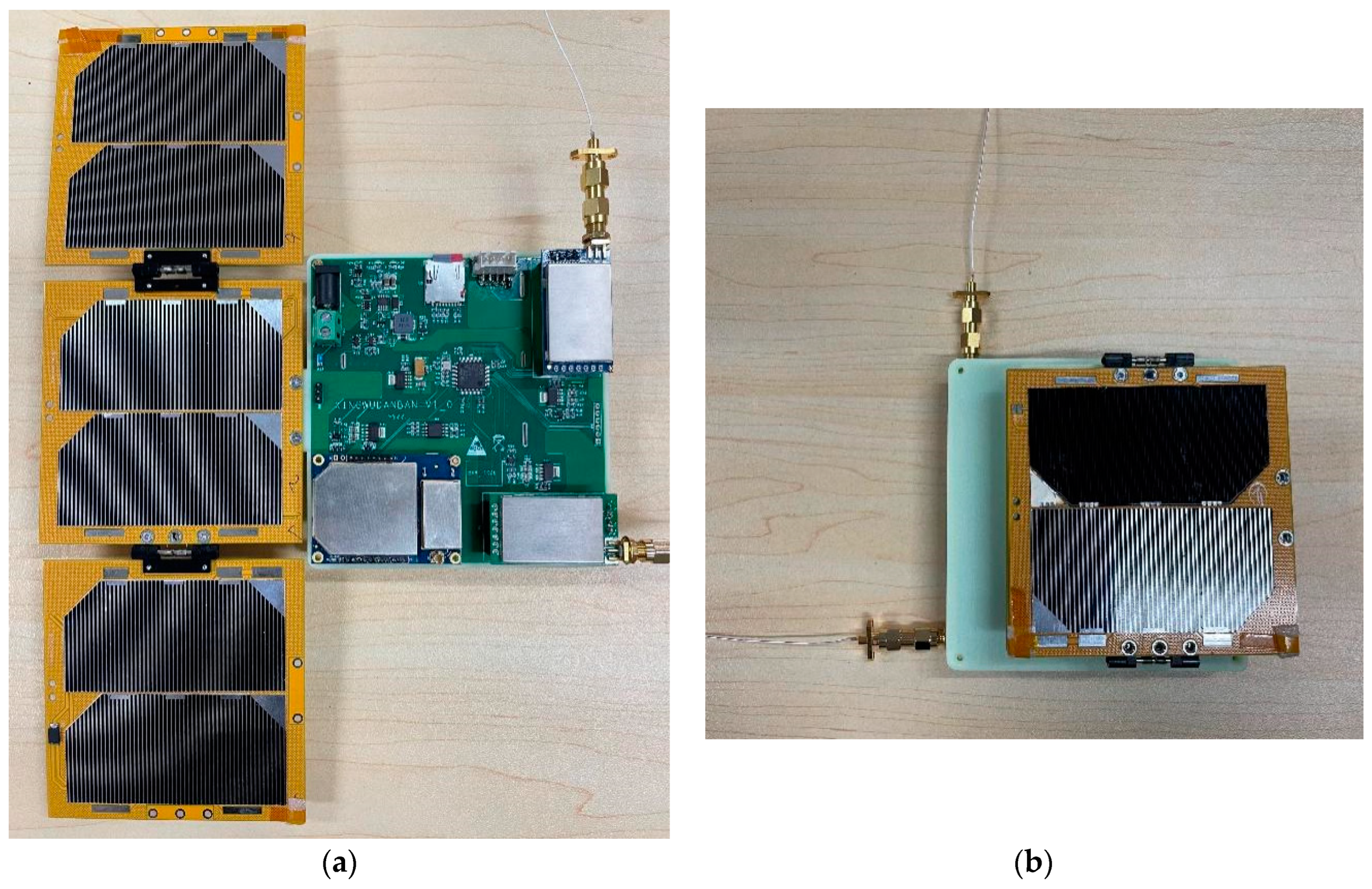
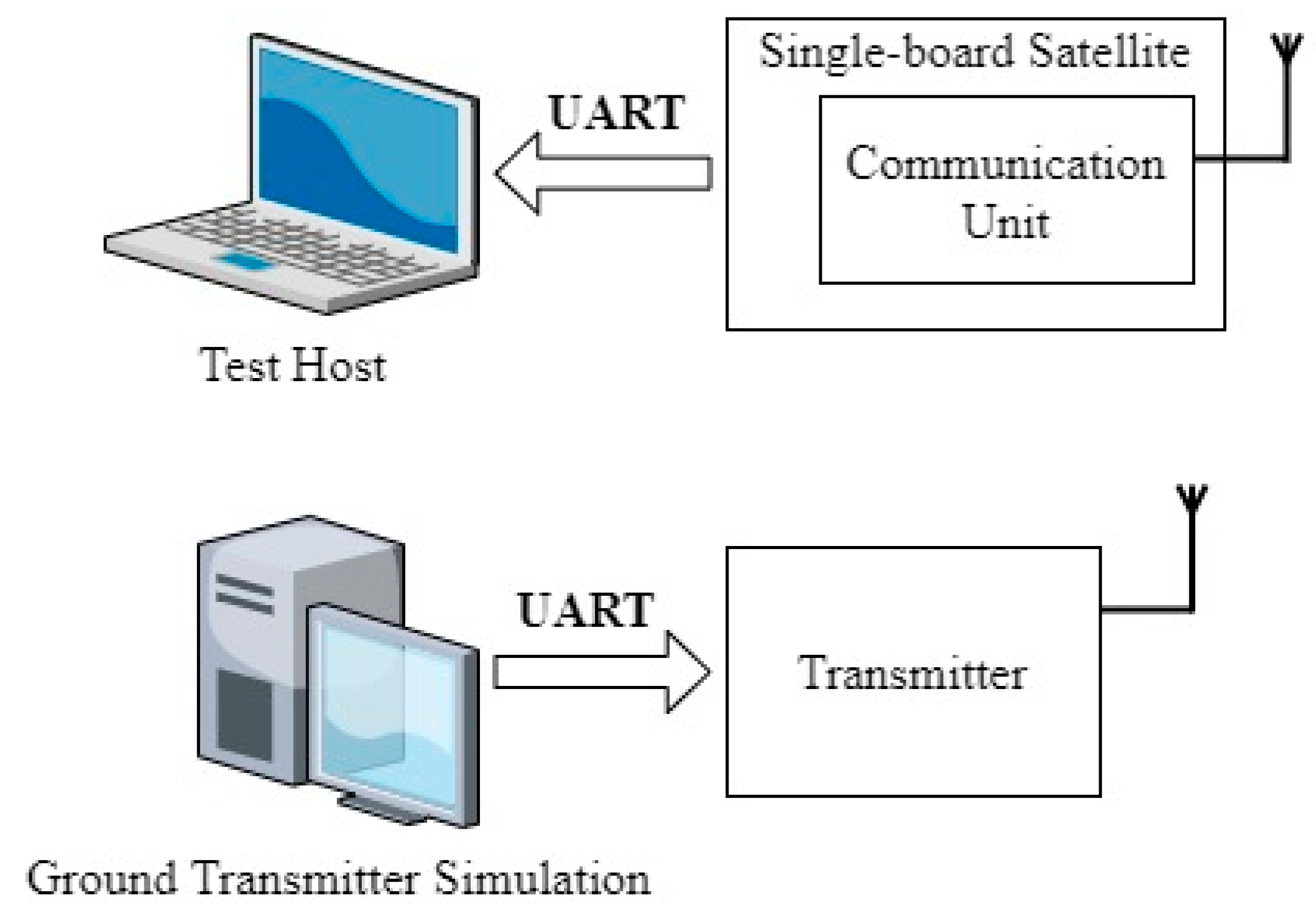

| Unit Name | Function | Requirement | Note | ||
|---|---|---|---|---|---|
| 1 | Energy unit | Solar sails | Harvest solar energy | Near omnidirectional | |
| Power circuit | Supply power to other modules | Includes battery | |||
| 2 | GNSS unit | GNSS antenna | Receive GNSS signals | Near omnidirectional | |
| GNSS receiver | Obtain position, velocity, pseudo-range, and phase information | ||||
| 3 | Communication unit | Transceiver antenna | Send/receive satellite-to-ground signals | Near omnidirectional | |
| Transceiver | Modulate send/demodulate receive signals | ||||
| 4 | Control and data processing unit | MCU | Mode switching Data integration | Low power consumption, online reconfiguration, and simple operations implemented | |
| 5 | Attitude control, propulsion, framework, thermal control, etc. | Not required | |||
| Work Mode | Communication | Detection | Standby | Reconfiguration |
|---|---|---|---|---|
| Control and data processing unit | √ | √ | √ | √ |
| GNSS unit | √ | √ | - | - |
| Communication unit | √ | - | - | - |
| Downlink | Uplink | Unit | |
|---|---|---|---|
| Transmit power | −3.0 | 15.0 | dBW |
| EIRP | −6.5 | 25.0 | dBi |
| Operating frequency | 433.0 | 170.0 | MHz |
| Maximum transmission distance | 1193 | 1193 | km |
| Free space path loss | −146.7 | −138.6 | dB |
| Other losses | −5.8 | −5.8 | dB |
| Q-factor | −8.8 | −33.5 | dB/K |
| Bit rate | 9600 | 4800 | bps |
| Eb/N0 | 10.5 | 13 | dB |
| Receiver sensitivity | - | −117.7 | dBm |
| Link margin | 10.5 | 25.9 | dB |
| Work Mode | Communication | Detection | Standby | Reconfiguration |
|---|---|---|---|---|
| Control and data processing unit | 0.25 W | 0.25 W | 0.25 W | 0.25 W |
| GNSS unit | 1.04 W | 1.04 W | - | - |
| Communication unit | 2.12 W | - | - | - |
| Power estimate | 3.41 W | 1.29 W | 0.25 W | 0.25 W |
| Work Mode | Communication | Detection |
|---|---|---|
| Power estimate | 3.41 W | 1.29 W |
| Period | 5 min | 90 min |
| Parameters | Value | Note |
|---|---|---|
| Size | 11 × 0.5 × 4 cm | Stowed |
| 11 × 10.5 × 2.5 cm | Deployed | |
| Weight | 266.9 g | |
| Transmitter power | 27 dBm | |
| Sensitivity | −120.0 dBm | |
| Battery capacity | 3200 mAh | |
| Solar panel | 12 | Double-sided installation |
| Power | 3.2 W | Communication |
| Size/cm | Weight/kg | Power/W | Reconfigurable | Independent Communication Capabilities | |
|---|---|---|---|---|---|
| NJUST-1 | 10 × 10 × 10 | 1.3 | 6.8 | √ | √ |
| PCBSat | 9.5 × 9 | 0.07 | 0.69 | × | × |
| RyeFemSat | 9 × 9 | 0.1 | 0.75 | × | × |
| StarDust | 6.5 × 5.5 | 0.03 | 0.68 | × | × |
| Prototype | 11 × 10.5 × 4 | 0.27 | 3.2 | √ | √ |
Disclaimer/Publisher’s Note: The statements, opinions and data contained in all publications are solely those of the individual author(s) and contributor(s) and not of MDPI and/or the editor(s). MDPI and/or the editor(s) disclaim responsibility for any injury to people or property resulting from any ideas, methods, instructions or products referred to in the content. |
© 2023 by the authors. Licensee MDPI, Basel, Switzerland. This article is an open access article distributed under the terms and conditions of the Creative Commons Attribution (CC BY) license (https://creativecommons.org/licenses/by/4.0/).
Share and Cite
Wang, Y.; Tu, C.; Wei, F.; Hu, X. Design of Novel Reconfigurable Single-Board Satellite for Enhanced Space Environment Detection. Electronics 2023, 12, 4761. https://doi.org/10.3390/electronics12234761
Wang Y, Tu C, Wei F, Hu X. Design of Novel Reconfigurable Single-Board Satellite for Enhanced Space Environment Detection. Electronics. 2023; 12(23):4761. https://doi.org/10.3390/electronics12234761
Chicago/Turabian StyleWang, Yixiao, Cui Tu, Feng Wei, and Xiong Hu. 2023. "Design of Novel Reconfigurable Single-Board Satellite for Enhanced Space Environment Detection" Electronics 12, no. 23: 4761. https://doi.org/10.3390/electronics12234761





